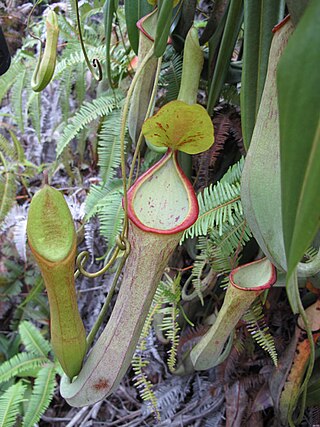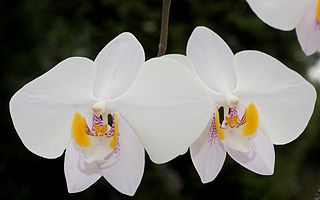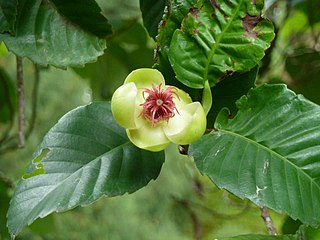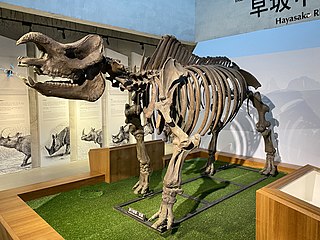
Nepenthes macrovulgaris, or the serpentine pitcher-plant, is a tropical pitcher plant endemic to Borneo. It is a lowland plant that typically grows at altitudes ranging from 300 to 1200 m in sub-montane forest clearings and mossy forest. Its range is restricted to ultramafic habitats, including Mount Kinabalu, Mount Tambuyukon, the Danum Valley, the Tawai Range, the Meliau Range and Mount Silam, all in Sabah, Malaysian Borneo. Pitchers grow to around 25 cm high and range in colour from green to brown, with the speckled form being the most common.

The Philippine cobra also called Philippine spitting cobra or northern Philippine cobra, is a stocky, highly venomous species of spitting cobra native to the northern regions of the Philippines. The Philippine cobra is called ulupong in Tagalog, carasaen in Ilocano.

Nepenthes philippinensis is a tropical pitcher plant endemic to the Philippines. It is known from Palawan and the neighbouring Calamian Islands and Linapacan, where it grows at 0–600 metres (2,000 ft) above sea level.

The yellow-bellied whistler, or Philippine whistler, is a species of bird in the family Pachycephalidae that is endemic to the Philippines. Its natural habitats are tropical moist lowland forest and the lower reaches tropical moist montane forest.

The Philippine tree squirrel is a species of rodent in the family Sciuridae which is endemic to the Philippines. The Philippine tree squirrel can only be found in Palawan, Bohol, Leyte and Samar and in Siargao. It is locally known as laksoy or kulagsing in the Visayan languages, like other endemic Philippine squirrels.

The large-eared horseshoe bat is a species of bat in the family Rhinolophidae. It is found in Australia, Indonesia, Malaysia, Papua New Guinea, and the Philippines.
Capillaria philippinensis is a parasitic nematode which causes intestinal capillariasis. This sometimes fatal disease was first discovered in Northern Luzon, Philippines, in 1964. Cases have also been reported from China, Egypt, Indonesia, Iran, Japan, Korea, Lao PDR, Taiwan and Thailand. Cases diagnosed in Italy and Spain were believed to be acquired abroad, with one case possibly contracted in Colombia. The natural life cycle of C. philippinensis is believed to involve fish as intermediate hosts, and fish-eating birds as definitive hosts. Humans acquire C. philippinensis by eating small species of infested fish whole and raw.

Tectona philippinensis, also called Philippine teak, is a species of plant in the family Lamiaceae, formerly classified in the Verbenaceae. It is endemic to the Philippines. The species is endangered due to land conversion and logging for its timber.

Amesiella philippinensis is a species of orchid endemic to the Island of Luzon in the Philippines. Like Vanda falcata it was mistaken as an Angraecum species, due to the white, long-spurred flowers. The plant produces rounded leaces up to 5 cm in length. Three or four white, fragrant flowers of 3 cm in width are produced on short inflorescences. The labellum is yellow in the throat. It occurs at lower altitudes than Amesiella monticola and has a shorter spur.

Intestinal capillariasis is a disease in the group of helminthiasis diseases caused by the nematode Capillaria philippinensis.

Phalaenopsis philippinensis is an endemic species of orchid found from Luzon island in the Philippines.
Echinolittorina philippinensis, is a species of sea snail, a marine gastropod mollusc in the family Littorinidae, the winkles or periwinkles.

Dillenia philippinensis (katmon) is a species of flowering plant in the family Dillenaceae. It is endemic to the Philippines and can be used for urban greening. Its fruit is known as elephant apple. Katmon grows in low to medium altitude forests throughout the Philippines, but does not survive the cold climates of the uplands.

Capillariidae is a family of parasitic nematodes. All its members are parasites in vertebrates when they are in their adult stage.

Peronosclerospora philippinensis, commonly known as Philippine downy mildew, is a species of mildew of the fungal-like protist class Oomycetes. It is related to Phytophthora infestans, which caused the potato blight that led to the Great Irish famine.
Agniohammus is a genus of longhorn beetles of the subfamily Lamiinae, containing the following species:
Agniohammus brunneus is a species of beetle in the family Cerambycidae. It was described by Stephan von Breuning in 1967, originally under the genus Elongatorsidis. It is known from Borneo.
Agniohammus olivaceus is a species of beetle in the family Cerambycidae. It was described by Stephan von Breuning in 1936. It is known from Sumatra and Malaysia.

Nesorhinus is an extinct genus of rhinoceros from the Pleistocene of Asia. It contains two species, Nesorhinus philippinensis from Luzon, Philippines and Nesorhinus hayasakai from Taiwan.

Amesiella monticola is a miniature species of epiphytic orchid native to the Philippines. The specific epithet "monticola" refers to the montaneous habitat of the species. Monticola is a combination of "mons" or "montis", meaning mountain and "cola" or "colere" meaning "inhabitant" or "dweller".














